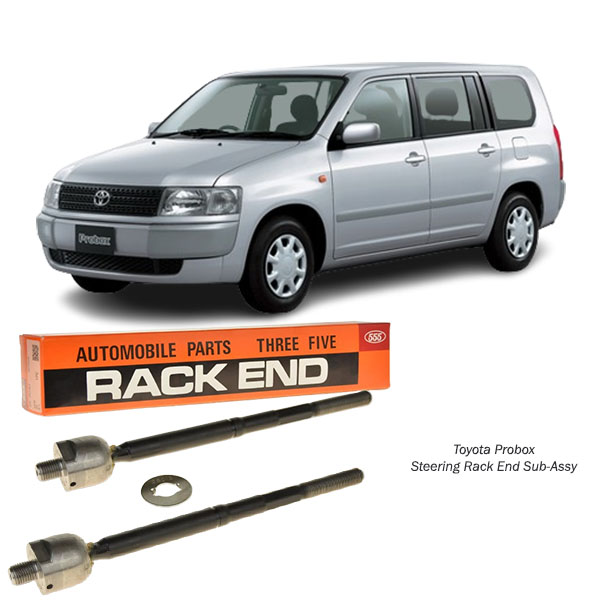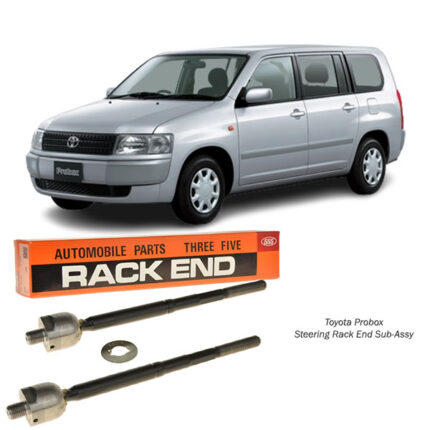Get Toyota Probox Steering Rack End Sub-Assy SR3600 in Kenya
The steering rack end sub-assy is an essential part of a vehicle’s steering system, directly contributing to the precision, responsiveness, and safety of your car’s handling. Its primary role is to connect the steering rack to the tie rod ends, which ultimately turn the wheels. Understanding the functions, benefits, maintenance, and replacement of this component is key to ensuring optimal vehicle performance and safety.
What is a Steering Rack End Sub-Assy?
The steering rack end sub-assy refers to a pre-assembled unit that includes the inner tie rods (or rack ends) and related hardware. It forms the critical link between the steering rack and the outer tie rods, translating the rotational motion of the steering wheel into the linear motion needed to turn the vehicle’s wheels.
Key Components:
- Inner Tie Rods
- Long rods that connect to the steering rack on one end and the outer tie rods on the other.
- Ball Joints
- Enable the tie rods to pivot smoothly, allowing for controlled wheel movement.
- Protective Boots (Optional)
- Rubber or plastic covers that shield the rack ends from dirt, moisture, and debris.
- Hardware
- Includes bolts, washers, and clamps for secure installation.
Functions of the Steering Rack End Sub-Assy
1. Translating Steering Input
The rack end transfers the motion of the steering rack to the outer tie rods, ensuring the wheels respond accurately to the driver’s steering input.
2. Enabling Wheel Movement
Through its ball joints, the rack end allows the wheels to pivot and turn while maintaining stability.
3. Dampening Vibrations
The rack end absorbs minor shocks and vibrations from the road, reducing wear on the steering system and improving driver comfort.
4. Maintaining Alignment
A properly functioning rack end ensures that the wheels remain aligned, promoting even tire wear and better control.
Benefits of a High-Quality Steering Rack End Sub-Assy
1. Enhanced Steering Precision
A reliable rack end ensures accurate wheel movement, resulting in precise and responsive handling.
2. Improved Safety
By maintaining proper wheel alignment and stability, a high-quality rack end contributes to safer driving.
3. Increased Durability
Premium components withstand wear and tear better, offering a longer service life and reduced maintenance costs.
4. Reduced Vibration and Noise
Smooth and efficient operation minimizes vibrations, reducing driver fatigue and improving ride quality.
5. Even Tire Wear
Proper alignment and stable operation prevent uneven tire wear, extending the lifespan of your tires.
Signs of a Failing Steering Rack End Sub-Assy
1. Loose Steering
Excessive play or looseness in the steering wheel may indicate a worn rack end.
2. Unusual Noises
Clunking or knocking sounds during steering could be caused by a failing ball joint or loose connection.
3. Poor Handling
Difficulty in maintaining a straight path or reduced responsiveness during cornering may signal a damaged rack end.
4. Uneven Tire Wear
Misalignment caused by a faulty rack end can lead to uneven wear patterns on the tires.
5. Vibrations in the Steering Wheel
Worn or loose rack ends can cause vibrations, especially at higher speeds or during braking.
Causes of Rack End Wear
- Frequent Driving on Rough Roads
Uneven terrain increases stress on the steering components, accelerating wear. - Age and Material Fatigue
Over time, the constant motion and load on the rack ends can lead to material degradation. - Lack of Maintenance
Neglecting regular inspections and lubrication can shorten the lifespan of the rack ends. - Exposure to Contaminants
Dirt, moisture, and road salt can corrode or degrade the materials, compromising performance. - Overloading the Vehicle
Excessive weight increases the strain on the steering and suspension systems, including the rack ends.
Maintenance Tips for Steering Rack Ends
1. Regular Inspections
Check the steering system during routine maintenance to identify wear or damage early.
2. Protective Boot Maintenance
Ensure the boots covering the rack ends are intact to prevent dirt and moisture from entering.
3. Proper Alignment
Have the vehicle’s wheel alignment checked periodically to prevent undue stress on the rack ends.
4. Use Quality Components
Replace worn parts with OEM or high-quality aftermarket products for reliability and longevity.
5. Lubricate Moving Parts
Some rack ends may benefit from periodic lubrication to reduce friction and wear.
Replacement of a Steering Rack End Sub-Assy
Replacing a rack end sub-assy is a detailed process requiring mechanical expertise. Here’s an overview of the steps involved:
Tools Required:
- Jack and jack stands
- Wrenches and socket set
- Tie rod end remover or pickle fork
- Torque wrench
Replacement Steps:
- Lift the Vehicle
Raise the car using a jack and secure it on jack stands to ensure safety. - Remove the Wheel
Detach the wheel to access the steering and suspension components. - Disconnect the Outer Tie Rod
Loosen the nut securing the outer tie rod to the knuckle and use a tie rod end remover to disconnect it. - Unscrew the Rack End
Loosen the lock nut and unscrew the rack end from the steering rack. - Install the New Rack End
Thread the new rack end onto the steering rack and tighten it according to the manufacturer’s specifications. - Reattach the Outer Tie Rod
Reconnect the outer tie rod to the knuckle and secure it with the nut. - Perform an Alignment
Have the wheel alignment checked and adjusted to ensure proper steering performance.
Advantages of Timely Rack End Replacement
1. Restored Steering Precision
Replacing worn rack ends ensures accurate and responsive steering.
2. Improved Vehicle Stability
A new rack end maintains proper wheel alignment, enhancing stability and control.
3. Extended Tire Lifespan
Proper alignment reduces uneven tire wear, saving money on replacements.
4. Enhanced Safety
Timely replacement prevents steering failure, ensuring safer driving conditions.
Choosing the Right Steering Rack End Sub-Assy
When purchasing a rack end sub-assy, consider the following:
1. Compatibility
Ensure the component is designed for your vehicle’s make and model.
2. Material Quality
Opt for parts made from durable materials to withstand wear and tear.
3. Manufacturer Reputation
Choose products from reputable manufacturers known for their quality and reliability.
4. Warranty
Look for components with a warranty to guarantee performance and durability.
Conclusion
The steering rack end sub-assy is a cornerstone of a vehicle’s steering system, providing the essential link between the steering rack and the wheels. Its role in translating steering input, maintaining alignment, and absorbing road shocks makes it a vital component for both performance and safety.
Regular maintenance, timely inspections, and the use of high-quality parts ensure the longevity and efficiency of the rack end, keeping your vehicle responsive and reliable. Whether you’re a professional mechanic or a car enthusiast, understanding the importance of this component empowers you to make informed decisions about your vehicle’s care.
Follow us on Facebook for more parts.




